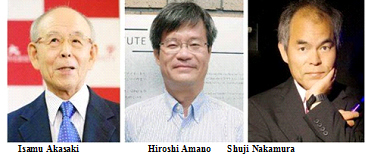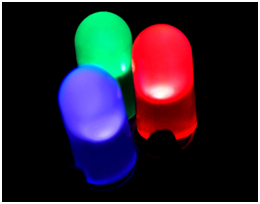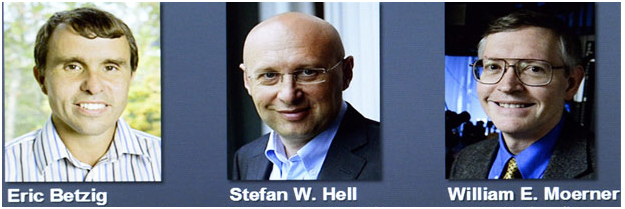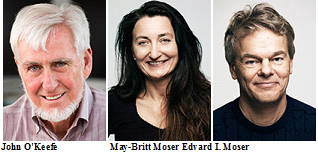Science and technology curious minds all over the world await eagerly every year for the deceleration of yearly noble prize winning fields/topics and winners in general and in Physics, Chemistry and Medicine in particular as these results act as a strong motivators for advanced research activities. This year (2014) the noble prizes declared in Physics, Chemistry and Medicine may belong to different discoveries in sciences and technology but have one thing in common and that is the role of electronics in those discoveries. Electronics is not only changing the lives of common men but also influencing the advances and frontiers of development in science & technology.
Physics Nobel Prize-2014
The Noble prize (2014) in Physics goes to the development of LEDs as smart sources of light in the times to come. It is only the understanding of electronic properties of advanced materials which have made LEDs possible. The Nobel Prize in Physics 2014 was awarded jointly to Isamu Akasaki, Hiroshi Amano and Shuji Nakamura “for the invention of efficient blue light-emitting diodes which has enabled bright and energy-saving white light sources”.
 Light can be produced and/or controlled electronically in a number of ways. In light emitting diodes (LEDs), light is produced by a solid state process called electroluminescence. Under specific conditions, solid state light sources can produce coherent light, as in laser diodes. Other devices such as liquid crystal devices (LCDs) control externally supplied light to form display units. One way to construct an LED is to deposit three semiconductor layers on a substrate. Between p-type and n-type semiconductor layers, an active region emits light when an electron and hole recombine. Considering the p-n combination to be a diode, then when the diode is forward biased, holes from the p-type material and electrons from the n-type material are both driven into the active region. The LED structure is placed in a tiny reflective cup so that the light from the active layer will be reflected toward the desired exit direction. When an LED is forward biased to the threshold of conduction, its current increases rapidly and must be controlled to prevent destruction of the device. The light output is quite linearly proportional to the current within its active region, so the light output can be precisely modulated to send an undistorted signal through a fiber optic cable.
Light can be produced and/or controlled electronically in a number of ways. In light emitting diodes (LEDs), light is produced by a solid state process called electroluminescence. Under specific conditions, solid state light sources can produce coherent light, as in laser diodes. Other devices such as liquid crystal devices (LCDs) control externally supplied light to form display units. One way to construct an LED is to deposit three semiconductor layers on a substrate. Between p-type and n-type semiconductor layers, an active region emits light when an electron and hole recombine. Considering the p-n combination to be a diode, then when the diode is forward biased, holes from the p-type material and electrons from the n-type material are both driven into the active region. The LED structure is placed in a tiny reflective cup so that the light from the active layer will be reflected toward the desired exit direction. When an LED is forward biased to the threshold of conduction, its current increases rapidly and must be controlled to prevent destruction of the device. The light output is quite linearly proportional to the current within its active region, so the light output can be precisely modulated to send an undistorted signal through a fiber optic cable.
 When bright blue light beams were produced from semi-conductors in the early 1990s, they triggered a fundamental transformation of lighting technology. Red and green diodes had been around for a long time but without blue light, white lamps could not be created. Despite considerable efforts, both in the scientific community and in industry, the blue LED had remained a challenge for three decades. Physics Nobel Laureates are rewarded for having invented a new energy-efficient and environment-friendly light source – the blue light-emitting diode (LED). In the
When bright blue light beams were produced from semi-conductors in the early 1990s, they triggered a fundamental transformation of lighting technology. Red and green diodes had been around for a long time but without blue light, white lamps could not be created. Despite considerable efforts, both in the scientific community and in industry, the blue LED had remained a challenge for three decades. Physics Nobel Laureates are rewarded for having invented a new energy-efficient and environment-friendly light source – the blue light-emitting diode (LED). In the
spirit of Alfred Nobel the Prize rewards an invention of greatest benefit to mankind; using blue LEDs, white light can be created in a new way. With the advent of LED lamps we now have more long-lasting and more efficient alternatives to older light sources. The LED lamp holds great promise for increasing the quality of life for over 1.5 billion people around the world who lack access to electricity grids: due to low power requirements it can be powered by cheap local solar power. The invention of the efficient blue LED is just twenty years old, but it has already contributed to create white light in an entirely new manner to the benefit of us all.
When bright blue light beams were produced from semi-conductors in the early 1990s, they triggered a fundamental transformation of lighting technology. Red and green diodes had been around for a long time but without blue light, white lamps could not be created. Despite considerable efforts, both in the scientific community and in industry, the blue LED had remained a challenge for three decades. White LED lamps emit a bright white light, are long-lasting and energy-efficient. They are constantly improved, getting more efficient with higher luminous flux (measured in lumen) per unit electrical input power (measured in watt). The most recent record is just over 300 lm/W, which can be compared to 16 for regular light bulbs and close to 70 for fluorescent lamps. As about one fourth of world electricity consumption is used for lighting purposes, the LEDs contribute to saving the Earth’s resources. Materials consumption is also diminished as LEDs last up to 100,000 hours, compared to 1,000 for incandescent bulbs and 10,000 hours for fluorescent lights. And this reveals something perhaps about the underlying dynamics of basic research, and about the push-and-pull between the more applied and the purer forms of physics. This is a reward for deep insight into physics that was produced with a specific tangible problem in mind.
Chemistry Nobel Prize-2014
The Royal Swedish Academy of Sciences has decided to award the Nobel Prize in Chemistry for 2014 to Eric Betzig, Stefan W. Hell and William E. Moerner “for the development of super-resolved fluorescence microscopy”. For a long time optical microscopy was held back by a presumed limitation: that it would never obtain a better resolution than half the wavelength of light. Helped by fluorescent molecules the Nobel Laureates in Chemistry 2014 ingeniously circumvented this limitation. Their ground-breaking work has brought optical microscopy into the nano-dimension. In what has become known as nanoscopy, scientists visualize the pathways of individual molecules inside living cells. They can see how molecules create synapses between nerve cells in the brain; they can track proteins involved in Parkinson’s, Alzheimer’s and Huntington’s diseases as they aggregate; they follow individual proteins in fertilized eggs as these divide into embryos.
 The wave nature of light and the associated diffraction not only undermine resolution of common light microscopes but also impose the difficulty of miniaturizing photonic devices such as fiber optic cables and couplers. In order for light-based circuitry to be competitive with current electronic circuits and to overcome the speed limitations of electronics, this size compatibility problem is a central challenge. Coupling the light into surface plasmons and using excited state interactions of molecules represent possible solutions. Fluorescence Resonance Energy Transfer (FRET) offers a means of excited state energy transport that is exploited in molecular photonic wires, devices that can be viewed as nano-scale optical waveguides. Over the past several decades, fluorescence microscopy has become an essential tool for examining a wide variety of biological molecules, pathways, and dynamics in living cells, tissues, and whole animals. In contrast to other techniques (such as electron microscopy), fluorescence imaging is compatible with cells that are being maintained in culture, which enables minimally invasive optical-based observation of events occurring on a large span of timescales. In terms of spatial resolution, several techniques including positron-emission tomography, magnetic resonance imaging, and optical coherence tomography can generate images of animal and human subjects at resolutions between 10 centimeters and 10 micrometers, whereas electron microscopy and scanning probe techniques feature the highest spatial resolution, often approaching the molecular and atomic levels. Between these two extremes in resolving power lies optical microscopy. The broad range of super resolution techniques available today are moving optical imaging of biological specimens into the realm traditionally held by electron microscopy, but some caution is warranted when interpreting the structures and molecular distributions that are observed. The major emphasis should be to assure that the techniques perform as advertised and do not create new artifacts that must be interpreted and alleviated.
The wave nature of light and the associated diffraction not only undermine resolution of common light microscopes but also impose the difficulty of miniaturizing photonic devices such as fiber optic cables and couplers. In order for light-based circuitry to be competitive with current electronic circuits and to overcome the speed limitations of electronics, this size compatibility problem is a central challenge. Coupling the light into surface plasmons and using excited state interactions of molecules represent possible solutions. Fluorescence Resonance Energy Transfer (FRET) offers a means of excited state energy transport that is exploited in molecular photonic wires, devices that can be viewed as nano-scale optical waveguides. Over the past several decades, fluorescence microscopy has become an essential tool for examining a wide variety of biological molecules, pathways, and dynamics in living cells, tissues, and whole animals. In contrast to other techniques (such as electron microscopy), fluorescence imaging is compatible with cells that are being maintained in culture, which enables minimally invasive optical-based observation of events occurring on a large span of timescales. In terms of spatial resolution, several techniques including positron-emission tomography, magnetic resonance imaging, and optical coherence tomography can generate images of animal and human subjects at resolutions between 10 centimeters and 10 micrometers, whereas electron microscopy and scanning probe techniques feature the highest spatial resolution, often approaching the molecular and atomic levels. Between these two extremes in resolving power lies optical microscopy. The broad range of super resolution techniques available today are moving optical imaging of biological specimens into the realm traditionally held by electron microscopy, but some caution is warranted when interpreting the structures and molecular distributions that are observed. The major emphasis should be to assure that the techniques perform as advertised and do not create new artifacts that must be interpreted and alleviated.
 It was all but obvious that scientists should ever be able to study living cells in the tiniest molecular detail. In 1873, the microscopist Ernst Abbe stipulated a physical limit for the maximum resolution of traditional optical microscopy: it could never become better than 0.2 micrometres. Eric Betzig, Stefan W. Hell and William E. Moerner are awarded the Nobel Prize in Chemistry 2014 for having bypassed this limit. Due to their achievements the optical microscope can now peer into the nanoworld. Two separate principles are rewarded. One enables the method stimulated emission depletion (STED) microscopy. Two laser beams are utilized; one stimulates fluorescent molecules to glow, another cancels out all fluorescence except for that in a nanometre-sized volume. Scanning over the sample, nanometre for nanometre, yields an image with a resolution better than Abbe’s stipulated limit. Eric Betzig and William Moerner, working separately, laid the foundation for the second method, single-molecule microscopy. The method relies upon the possibility to turn the fluorescence of individual molecules on and off. Scientists image the same area multiple times, letting just a few interspersed molecules glow each time. Superimposing these images yields a dense super-image resolved at the nanolevel. In 2006 Eric Betzig utilized this method for the first time. Today, nanoscopy is used world-wide and new knowledge of greatest benefit to mankind is produced on a daily basis.
It was all but obvious that scientists should ever be able to study living cells in the tiniest molecular detail. In 1873, the microscopist Ernst Abbe stipulated a physical limit for the maximum resolution of traditional optical microscopy: it could never become better than 0.2 micrometres. Eric Betzig, Stefan W. Hell and William E. Moerner are awarded the Nobel Prize in Chemistry 2014 for having bypassed this limit. Due to their achievements the optical microscope can now peer into the nanoworld. Two separate principles are rewarded. One enables the method stimulated emission depletion (STED) microscopy. Two laser beams are utilized; one stimulates fluorescent molecules to glow, another cancels out all fluorescence except for that in a nanometre-sized volume. Scanning over the sample, nanometre for nanometre, yields an image with a resolution better than Abbe’s stipulated limit. Eric Betzig and William Moerner, working separately, laid the foundation for the second method, single-molecule microscopy. The method relies upon the possibility to turn the fluorescence of individual molecules on and off. Scientists image the same area multiple times, letting just a few interspersed molecules glow each time. Superimposing these images yields a dense super-image resolved at the nanolevel. In 2006 Eric Betzig utilized this method for the first time. Today, nanoscopy is used world-wide and new knowledge of greatest benefit to mankind is produced on a daily basis.
Physiology or Medicine Nobel Prize-2014
The Nobel Prize in Physiology or Medicine 2014 was divided; one half awarded to John O’Keefe, the other half jointly to May-Britt Moser and Edvard I. Moser “for their discoveries of cells that constitute a positioning system in the brain”. How do we know where we are? How can we find the way from one place to another? And how can we store this information in such a way that we can immediately find the way the next time we trace the same path? This year’s Nobel Laureates have discovered a positioning system, an “inner GPS” in the brain that makes it possible to orient ourselves in space, demonstrating a cellular basis for higher cognitive function.
 The work has also given them traction at one of the most challenging twenty-first-century research frontiers: how the brain computes. Just as computers use programming languages, the brain seems to have its own operating languages — a bewildering set of codes hidden in the minds and timing with which neurons fire as well as the rhythmic electrical activities that oscillate through brain circuits. These codes allow the brain to represent features of the external world — such as sound, light, smell and position in space — in a language that it can understand and compute. With the grid-cell work, scientists have been the first to crack one such code deep in the brain; now the challenge for the field is to find all the rest. One virtual-reality experiment they are planning will record from electrodes in rats running on a stationary ball surrounded by screens showing changing environments. The rats’ heads will be held still so that it becomes possible to place electrodes directly inside individual cells for the first time, and to insert small lenses that allow the researchers to simultaneously examine those cells under a microscope. This will reveal precisely which of the many cell types are firing at any one time as the rats move around the virtual space.
The work has also given them traction at one of the most challenging twenty-first-century research frontiers: how the brain computes. Just as computers use programming languages, the brain seems to have its own operating languages — a bewildering set of codes hidden in the minds and timing with which neurons fire as well as the rhythmic electrical activities that oscillate through brain circuits. These codes allow the brain to represent features of the external world — such as sound, light, smell and position in space — in a language that it can understand and compute. With the grid-cell work, scientists have been the first to crack one such code deep in the brain; now the challenge for the field is to find all the rest. One virtual-reality experiment they are planning will record from electrodes in rats running on a stationary ball surrounded by screens showing changing environments. The rats’ heads will be held still so that it becomes possible to place electrodes directly inside individual cells for the first time, and to insert small lenses that allow the researchers to simultaneously examine those cells under a microscope. This will reveal precisely which of the many cell types are firing at any one time as the rats move around the virtual space.
In 1971, John O’Keefe discovered the first component of this positioning system. He found that a type of nerve cell in an area of the brain called the hippocampus that was always activated when a rat was at a certain place in a room. Other nerve cells were activated when the rat was at other places. O’Keefe concluded that these “place cells” formed a map of the room. More than three decades later, in 2005, May-Britt and Edvard Moser discovered another key component of the brain’s positioning system. They identified another type of nerve cell, which they called “grid cells”, that generate a coordinate system and allow for precise positioning and path finding. Their subsequent research showed how
place and grid cells make it possible to determine position and to navigate. The sense of place and the ability to navigate are fundamental to our existence. The sense of place gives a perception of position in the environment. During navigation, it is interlinked with a sense of distance that is based on motion and knowledge of previous positions.
When recording signals from individual nerve cells in a part of the brain called the hippocampus, in rats moving freely in a room, O’Keefe discovered that certain nerve cells were activated when the animal assumed a particular place in the environment. He could demonstrate that these “place cells” were not merely registering visual input, but were building up an inner map of the environment. O’Keefe concluded that the hippocampus generates numerous maps, represented by the collective activity of place cells that are activated in different environments. Therefore, the memory of an environment can be stored as a specific combination of place cell activities in the hippocampus. May-Britt and Edvard Moser were mapping the connections to the hippocampus in rats moving in a room when they discovered an astonishing pattern of activity in a nearby part of the brain called the entorhinal cortex. Here, certain cells were activated when the rat passed multiple locations arranged in a hexagonal grid. Each of these cells was activated in a unique spatial pattern and collectively these “grid cells” constitute a coordinate system that allows for spatial navigation. Together with other cells of the entorhinal cortex that recognize the direction of the head and the border of the room, they form circuits with the place cells in the hippocampus. This circuitry constitutes a comprehensive positioning system, an inner GPS, in the brain.
Recent investigations with brain imaging techniques, as well as studies of patients undergoing neurosurgery, have provided evidence that place and grid cells exist also in humans. In patients with Alzheimer’s disease, the hippocampus and entorhinal cortex are frequently affected at an early stage, and these individuals often lose their way and cannot recognize the environment. Knowledge about the brain’s positioning system may, therefore, help us understand the mechanism underpinning the devastating spatial memory loss that affects people with this disease. The discovery of the brain’s positioning system represents a paradigm shift in our understanding of how ensembles of specialized cells work together to execute higher cognitive functions. It has opened new avenues for understanding other cognitive processes, such as memory, thinking and planning.
Acknowledgement: The use of information retrieved through various references/sources of internet in this article is highly acknowledged.






